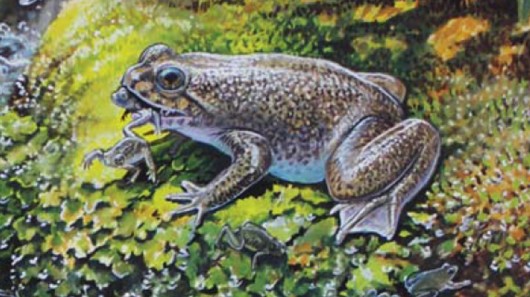
An artist’s impression of the gastric-brooding frog that was cloned by scientists working on the Lazarus Project (Artwork: Peter Schouten)
Australian scientists have successfully revived and reactivated the genome of an extinct frog. The "Lazarus Project" team implanted cell nuclei from tissues collected in the 1970s and kept in a conventional deep freezer for 40 years into donor eggs from a distantly-related frog. Some of the eggs spontaneously began to divide and grow to early embryo stage with tests confirming the dividing cells contained genetic material from the extinct frog.
The extinct frog in question is the Rheobatrachus silus, one of only two species of gastric-brooding frogs, or Platypus frogs, native to Queensland, Australia. Both species became extinct in the mid-1980s and were unique amongst frog species for the way in which they incubated their offspring. After the eggs were fertilized by the male, the female would then swallow the eggs until they hatched. The tadpoles would then develop in the female’s stomach for at least six weeks – during which time the female would not eat – before being regurgitated and raised in shallow water.
With the aim of bringing the frog back from extinction, the Lazarus Project team took fresh donor eggs from the Great Barred Frog, another Australian ground-swelling frog that is distantly related to the gastric-brooding frog. The scientists inactivated the egg nuclei from the donor eggs and replaced them with dead nuclei from the extinct frog in a technique known as somatic-cell nuclear transfer (SCNT), which was the basis for the cloning of Dolly the sheep and, more recently, 581 clones from one “donor” mouse.
Although none of the embryos survived longer than a few days, the work is encouraging for others looking to clone a variety of currently-extinct animals, such as the woolly mammoth, dodo, Cuban red macaw and New Zealand’s giant moa.
“We are watching Lazarus arise from the dead, step by exciting step,” says the leader of the Lazarus Project team, Professor Mike Archer, of the University of New South Wales, Sydney. “We’ve reactivated dead cells into living ones and revived the extinct frog’s genome in the process. Now we have fresh cryo-preserved cells of the extinct frog to use in future cloning experiments.
“We’re increasingly confident that the hurdles ahead are technological and not biological and that we will succeed. Importantly, we’ve demonstrated already the great promise this technology has as a conservation tool when hundreds of the world’s amphibian species are in catastrophic decline.”
Professor Archer spoke last week at the TEDx DeExtinction event in Washington, D.C., where he talked publicly about the Lazarus Project for the first time, as well as his ongoing interest in cloning the extinct Tasmanian tiger.
The Lazarus Project team's results are yet to be published.
Source: University of New South Wales
Copyright © gizmag 2003 - 2013 To subscribe or visit go to: http://www.gizmag.com